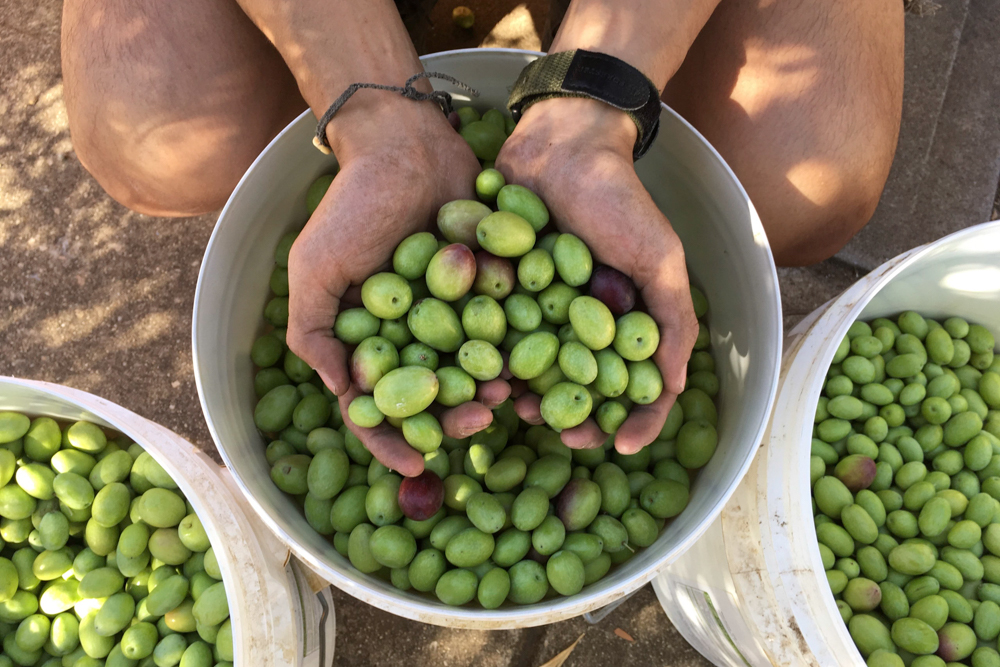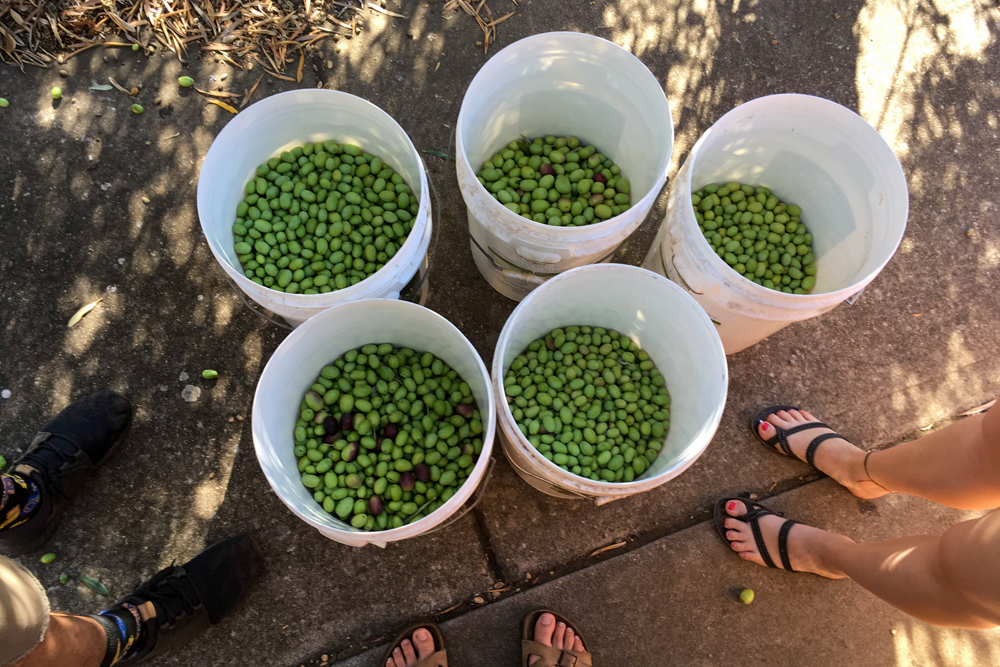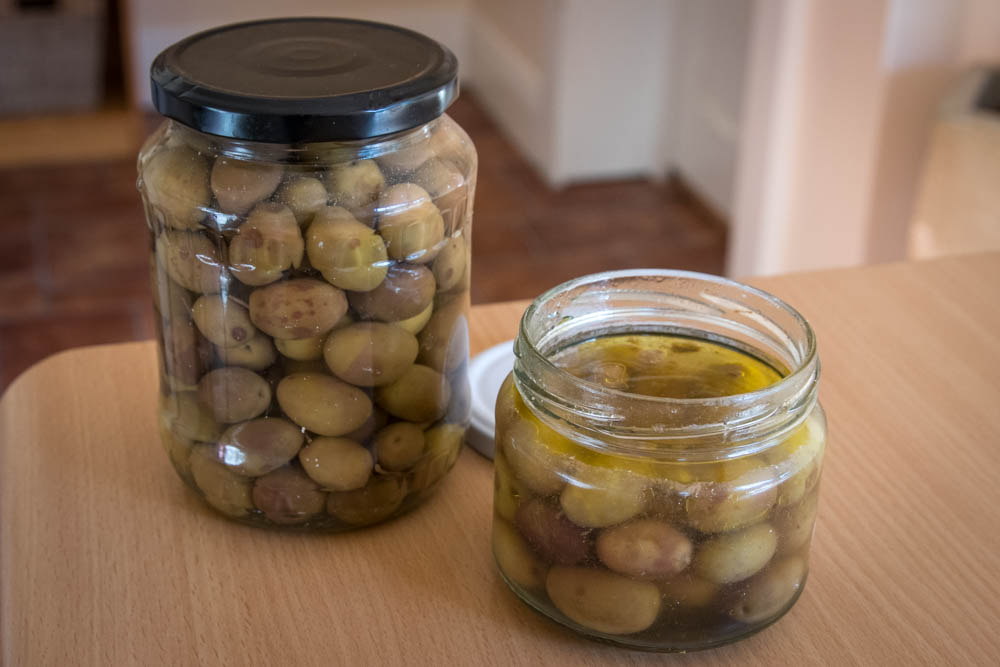
Random street olive trees deliver me a bounty every year.
Three large trees grow on a suburban street verge five minutes from my Adelaide home and, come late summer, they’re usually laden with fruit.
Some searingly hot day, I usually rope a (somewhat begrudging) group of mates into picking literal bucketloads, so we have olives coming out of our ears when they’re ready a few months later … which is OK by me. Home-cured olives are delicious and a jar or two makes for a brilliant last-minute homemade gift.

This coming season will be my fourth year making my own olives from a foraged harvest. I use an old Italian style to prepare them.
First, they go into a cooler box to soak in rainwater, with the water changed daily for 12 days. (The cooler box thing is my genius hack from two years ago – the plughole at the bottom makes changing the water each day a cinch.)

Then: into food-grade plastic buckets – plenty of businesses give these away for free – filled with a salty brine. And that’s it.
They need a couple of months in the brine before eating, then keep for at least a year (often longer) in that same brine.
I reckon this way is much better than recipes that call for daily brine changes for the first fortnight, which leaves you with salty wastewater to dispose of. This way, the daily rainwater can just be poured straight onto your thirsty summer garden.
I often field lots of questions about this process, so I’ve finally documented the full recipe in detail below.
Olives grow abundantly in so many cities (they’re often considered an environmental weed), yet often go unpicked. Why not go for a walk, find a tree in your neighbourhood and give it a go?

Home-cured Italian-style olives
Ingredients
Fresh-picked olives (extra points if they’re foraged)
Rainwater
Salt
A little olive oil (optional)
Note: You can pick the olives while green or wait a little longer until they ripen further and turn purple. It’s totally up to your own personal preference.
Method
Find a tree or three and wait until the fruit ripens (in southern Australia, that’s usually sometime between February and April). Gather some friends and pick the olives, avoiding taking too much stem. Place them gently into your picking buckets to avoid bruising the fruit.

Back at home, place the olives into a container large enough to hold them all. (Pro tip: use a cooler box with a plug at the bottom, as it will be much easier to drain off the water each day.) Fill the container with rainwater so all olives are covered; they’ll float, but that’s OK.
Change the water every day for at least 12 days. If your olives are really large, they’ll benefit from longer – up to 15 days.
This starts to release the bitterness. You will see, day by day, that the olives release more of a foamy, slimy texture (delicious, right?), caused by the bitterness and also a little of the oil content. So after draining out yesterday’s water, given them a little rinse before refilling. This is especially important in the last few days.

On the final day, drain and rinse the olives.
Making the saltwater brine
To cure the olives, they need to rest in a saltwater brine for a few months.
You need a 3:1 ratio of olives to saltwater brine. For example, for every full bucket of olives, you’ll need about a third of a bucket of brine.
Find a food-grade container or bucket/s large enough to fit all your olives. Boil some water and start adding fistfuls of salt into the container, stirring to dissolve. Use a raw egg (still in its shell) to determine when you have enough salt – keep adding more until the egg placed in the water floats just off the bottom of the container.
Wait for the water to cool completely, then add the olives and ensure they’re completely covered in water.

Pro tip: Cover the olives with a thin layer of olive oil, or lay a large plate on top of them (inside the bucket) to push them all under the salty brine. This prevents air from touching the fruit, which helps to prevent creamy-white Kahm yeast from growing on the surface. You may still get some (you can see a bit in the photo above) and this is totally OK as long as you don’t see any actual mould – just rinse off the olives and they’ll be fine to eat.
Leave the olives in the brine for at least three months, in a cool and dark place.
Taste them at the three-month mark – if they’re hard and you’d prefer them softer, leave for a little longer. If they’re too salty, you can change the brine and make it less salty. You can also add 10% vinegar to the brine for a little more flavour and to help preserve your olives, but this is not essential.

Your cured olives in brine will keep for at least a year, often longer.
I keep everything in the large bucket and spoon them out into smaller jars as needed – I always have a huge jar for myself in my fridge and often give smaller jars away to friends.
When spooning into smaller jars, cover the olives with brine from the larger bucket, to ensure they’ll keep for months. As you’re removing olives from the big bucket, check the olive oil layer and top up if necessary – this will help them keep for longer.

Adding flavours to your cured olives
Once your olives are fully cured, there are two ways to add yum flavours using herbs and spices.
Infusion: you can split some olives into a smaller jar and add things to the brine, such as dried and crushed chillies, bay leaves, fennel seeds, vinegar, etc. Leave to sit for a couple of weeks and the flavour will gently infuse.
Frying: alternatively, you can quickly jazz them up just before eating by heating a little oil in a pan, adding things like garlic and spices, and gently frying for a few minutes. They’re especially delicious served warm.
Or just eat them exactly as is. They’re great straight out the jar too.
So, hop to it — find a tree near your place and get a’picking. Let me know how you go?
⠀
Extra reading:
If you have a lot of salt lying around, and the olives you’ve harvested are on the smaller side, you might like to try this dry salted olives recipe from Milkwood.

![[Video] How to build a business that values people, planet and profit](https://korenhelbig.com/wp-content/uploads/2024/08/How-To-Build-A-Business-That-Values-People-Profit-The-Planet-an-interview-Koren-Helbig-and-Honey-Atkinson-1-500x383.png)
![[Podcast] Work/rest balance — a Reskilliance chat with Catie Payne](https://korenhelbig.com/wp-content/uploads/2024/08/Reskilliance-podcast-cover-500x383.jpg)
![[Video] Take a walk through my urban Adelaide permaculture garden](https://korenhelbig.com/wp-content/uploads/2024/06/Forward-Thinkers-video-500x383.png)

